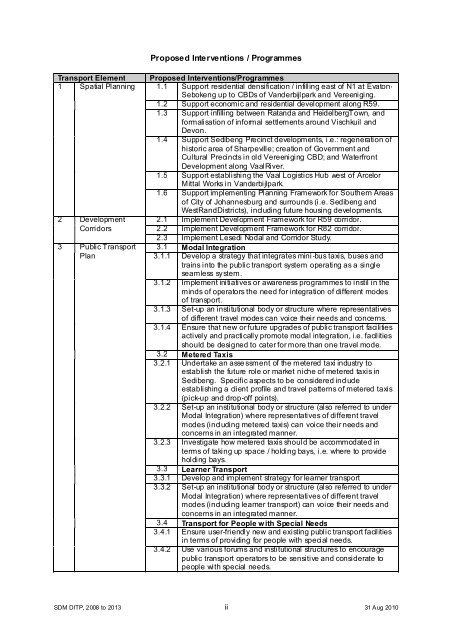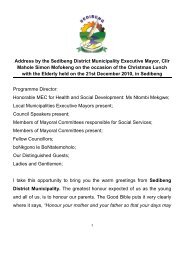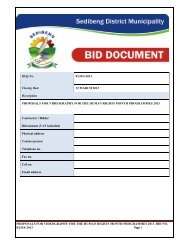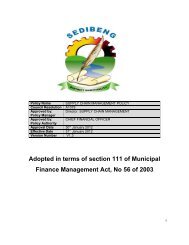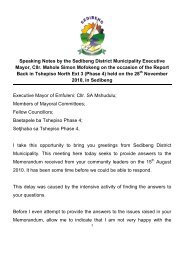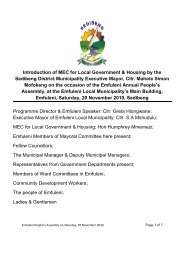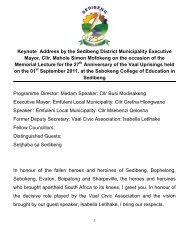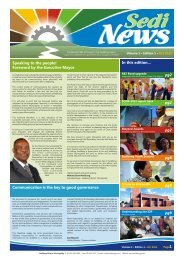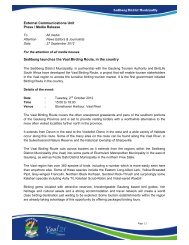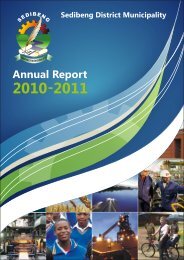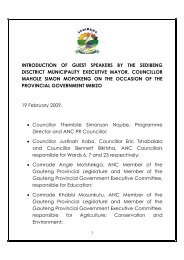Chapter 11 - Sedibeng District Municipality
Chapter 11 - Sedibeng District Municipality
Chapter 11 - Sedibeng District Municipality
Create successful ePaper yourself
Turn your PDF publications into a flip-book with our unique Google optimized e-Paper software.
Proposed Interventions / Programmes<br />
Transport Element Proposed Interventions/Programmes<br />
1 Spatial Planning 1.1 Support residential densification / infilling east of N1 at Evaton-<br />
Sebokeng up to CBDs of Vanderbijlpark and Vereeniging.<br />
1.2 Support economic and residential development along R59.<br />
1.3 Support infilling between Ratanda and HeidelbergTown, and<br />
formalisation of informal settlements around Vischkuil and<br />
Devon.<br />
1.4 Support <strong>Sedibeng</strong> Precinct developments, i.e.: regeneration of<br />
historic area of Sharpeville; creation of Government and<br />
Cultural Precincts in old Vereeniging CBD; and Waterfront<br />
Development along VaalRiver.<br />
1.5 Support establishing the Vaal Logistics Hub west of Arcelor<br />
Mittal Works in Vanderbijlpark.<br />
1.6 Support implementing Planning Framework for Southern Areas<br />
of City of Johannesburg and surrounds (i.e. <strong>Sedibeng</strong> and<br />
WestRand<strong>District</strong>s), including future housing developments.<br />
2 Development 2.1 Implement Development Framework for R59 corridor.<br />
Corridors<br />
2.2 Implement Development Framework for R82 corridor.<br />
3 Public Transport<br />
Plan<br />
2.3 Implement Lesedi Nodal and Corridor Study.<br />
3.1 Modal Integration<br />
3.1.1 Develop a strategy that integrates mini-bus taxis, buses and<br />
trains into the public transport system operating as a single<br />
seamless system.<br />
3.1.2 Implement initiatives or awareness programmes to instil in the<br />
minds of operators the need for integration of different modes<br />
of transport.<br />
3.1.3 Set-up an institutional body or structure where representatives<br />
of different travel modes can voice their needs and concerns.<br />
3.1.4 Ensure that new or future upgrades of public transport facilities<br />
actively and practically promote modal integration, i.e. facilities<br />
should be designed to cater for more than one travel mode.<br />
3.2 Metered Taxis<br />
3.2.1 Undertake an asse ssment of the metered taxi industry to<br />
establish the future role or market niche of metered taxis in<br />
<strong>Sedibeng</strong>. Specific aspects to be considered include<br />
establishing a client profile and travel patterns of metered taxis<br />
(pick-up and drop-off points).<br />
3.2.2 Set-up an institutional body or structure (also referred to under<br />
Modal Integration) where representatives of different travel<br />
modes (including metered taxis) can voice their needs and<br />
concerns in an integrated manner.<br />
3.2.3 Investigate how metered taxis should be accommodated in<br />
terms of taking up space / holding bays, i.e. where to provide<br />
holding bays.<br />
3.3 Learner Transport<br />
3.3.1 Develop and implement strategy for learner transport<br />
3.3.2 Set-up an institutional body or structure (also referred to under<br />
Modal Integration) where representatives of different travel<br />
modes (including learner transport) can voice their needs and<br />
concerns in an integrated manner.<br />
3.4 Transport for People with Special Needs<br />
3.4.1 Ensure user-friendly new and existing public transport facilities<br />
in terms of providing for people with special needs.<br />
3.4.2 Use various forums and institutional structures to encourage<br />
public transport operators to be sensitive and considerate to<br />
people with special needs.<br />
SDM DITP, 2008 to 2013 ii 31 Aug 2010


